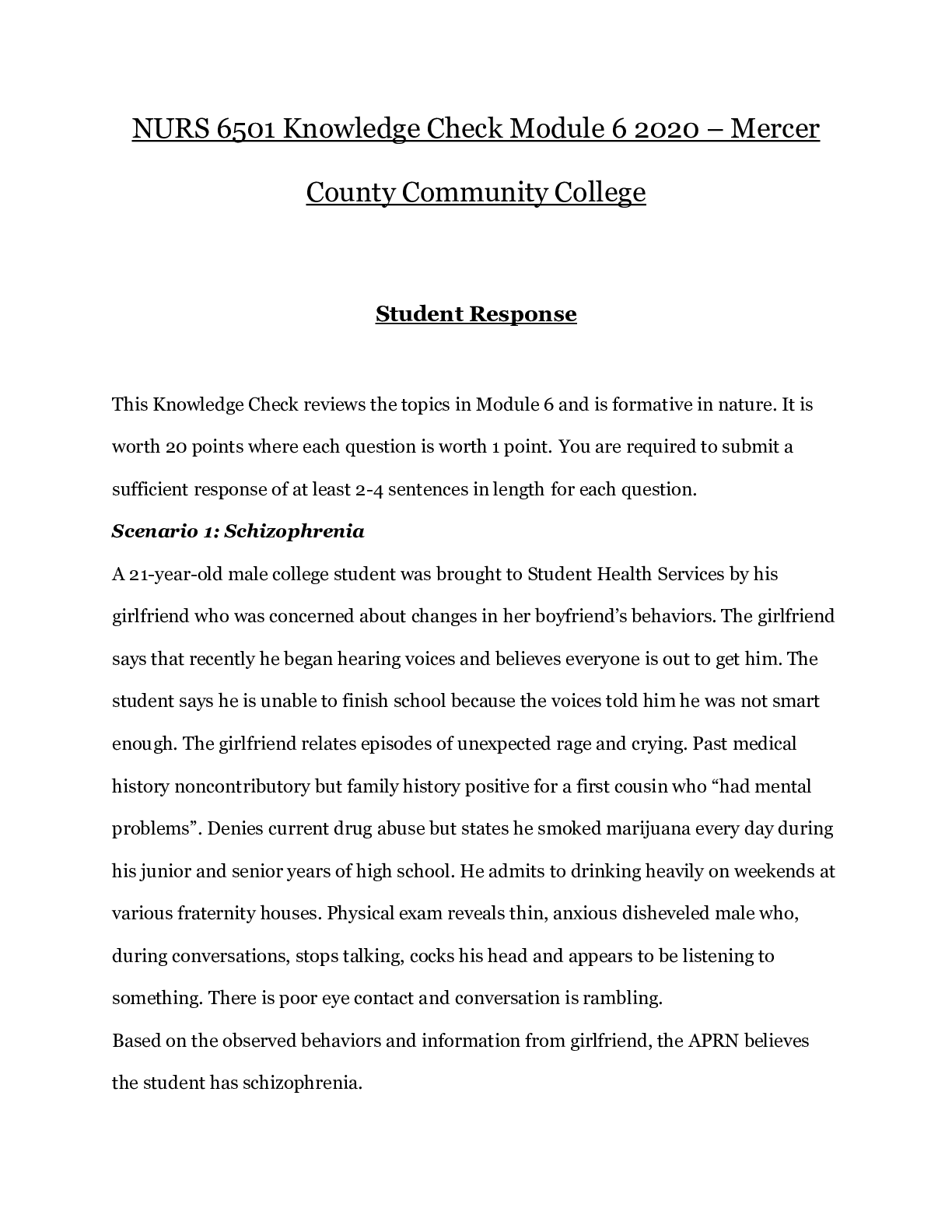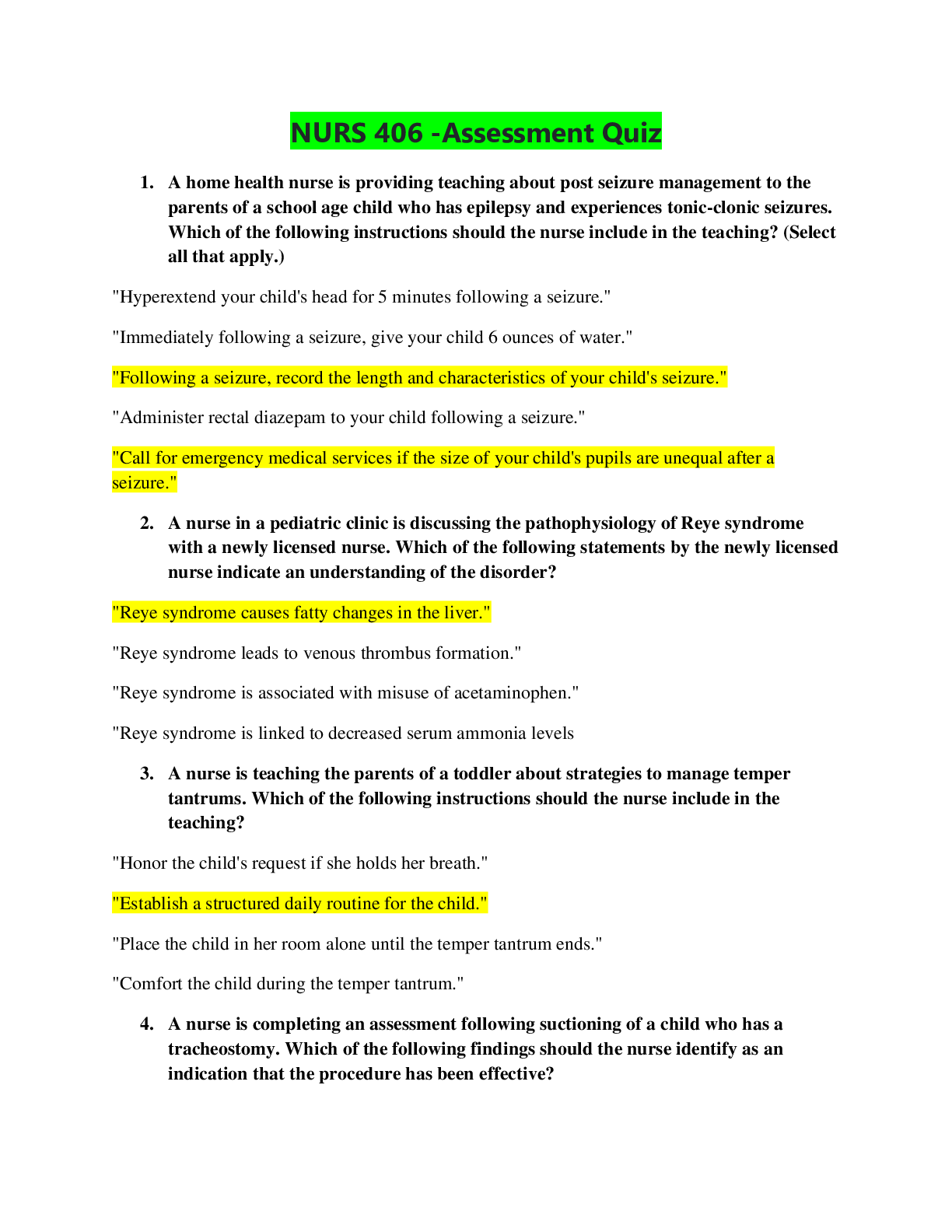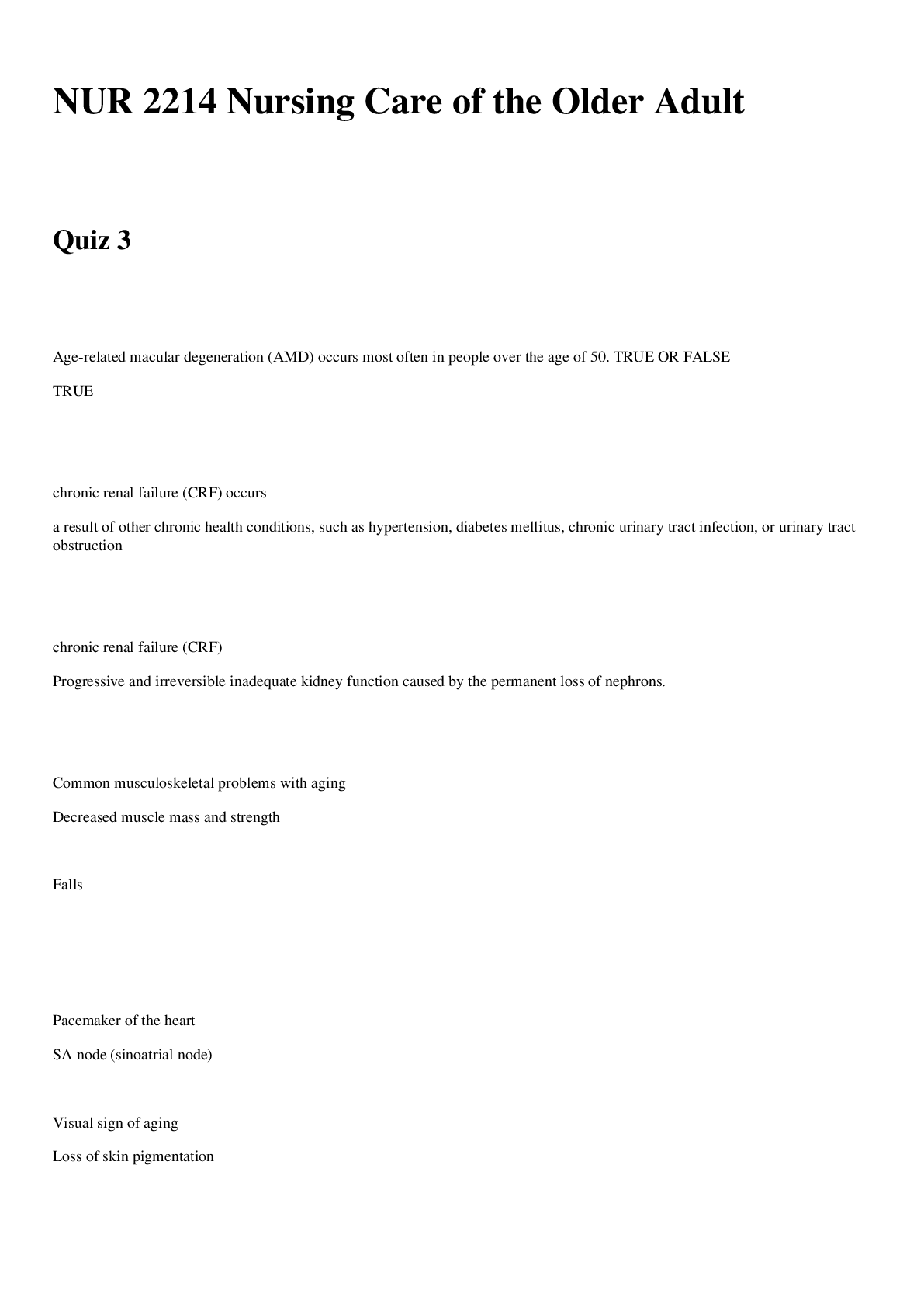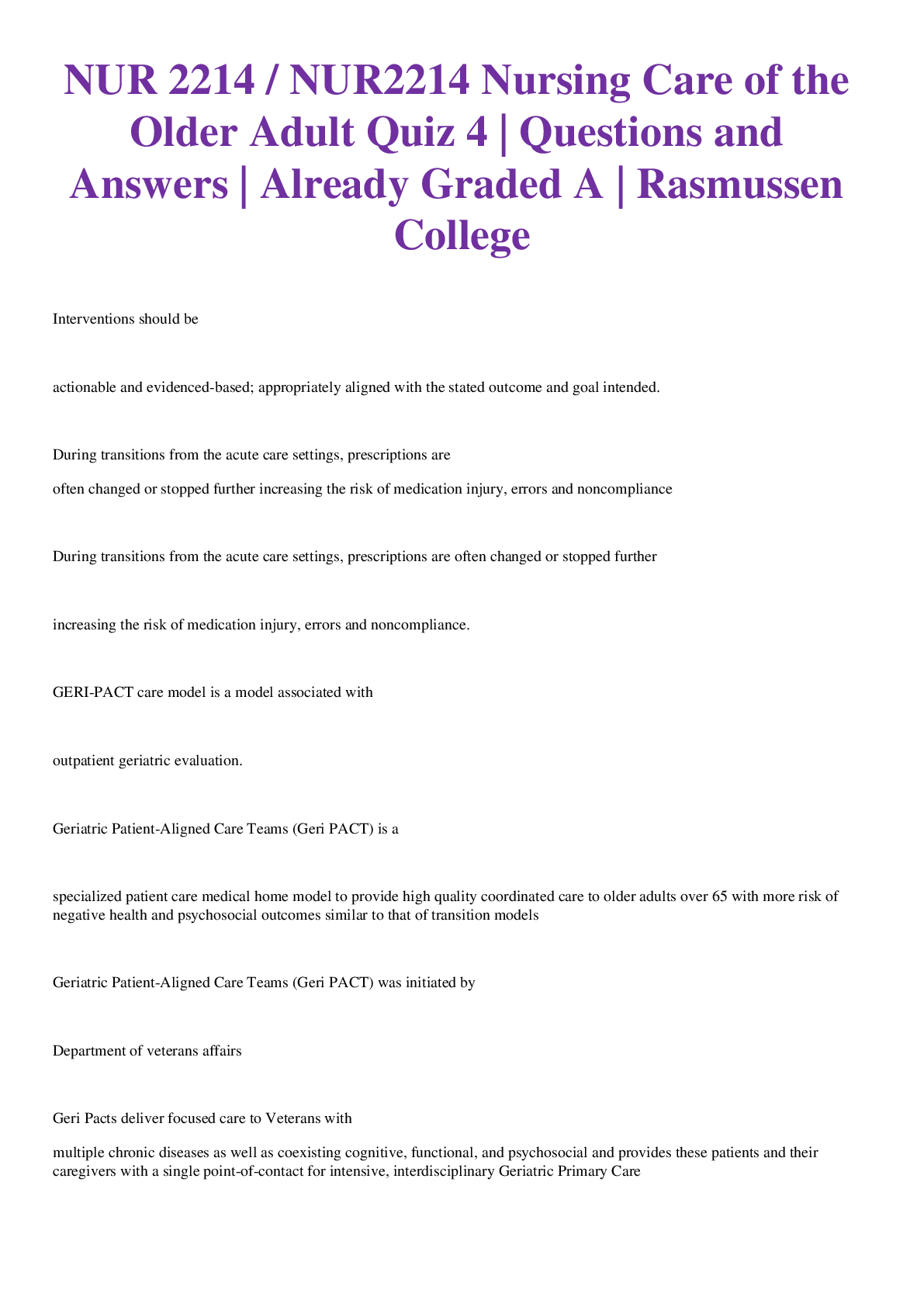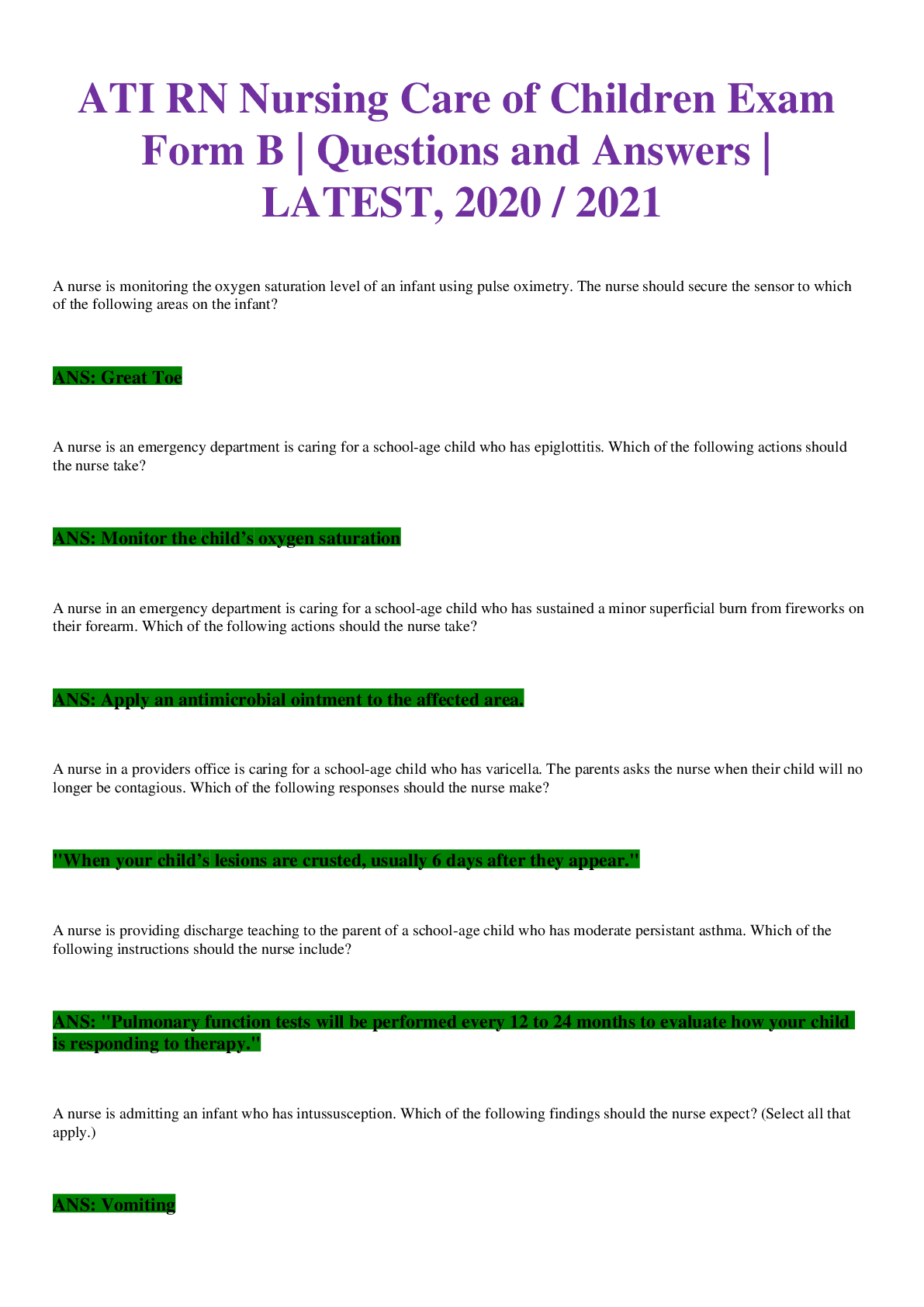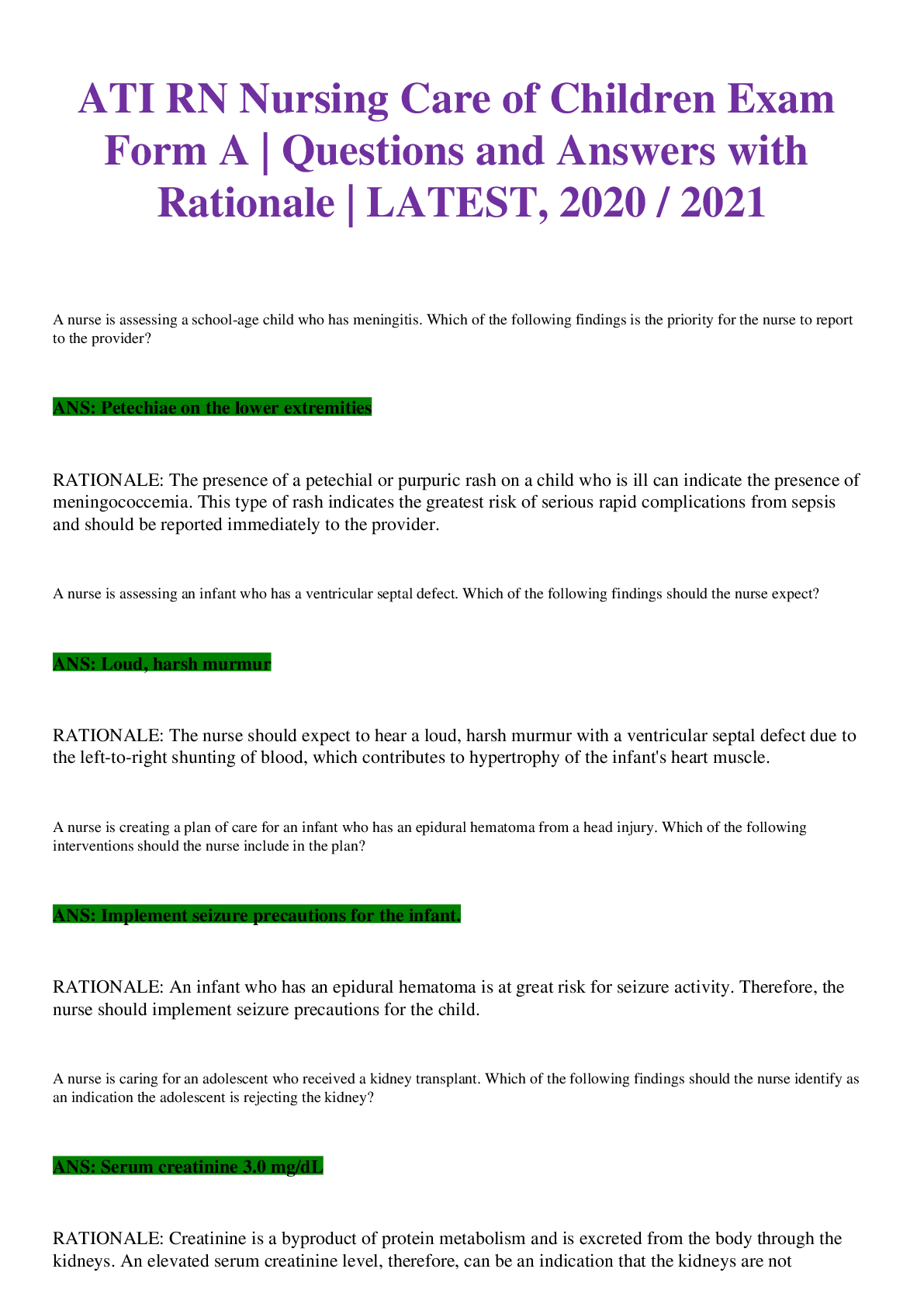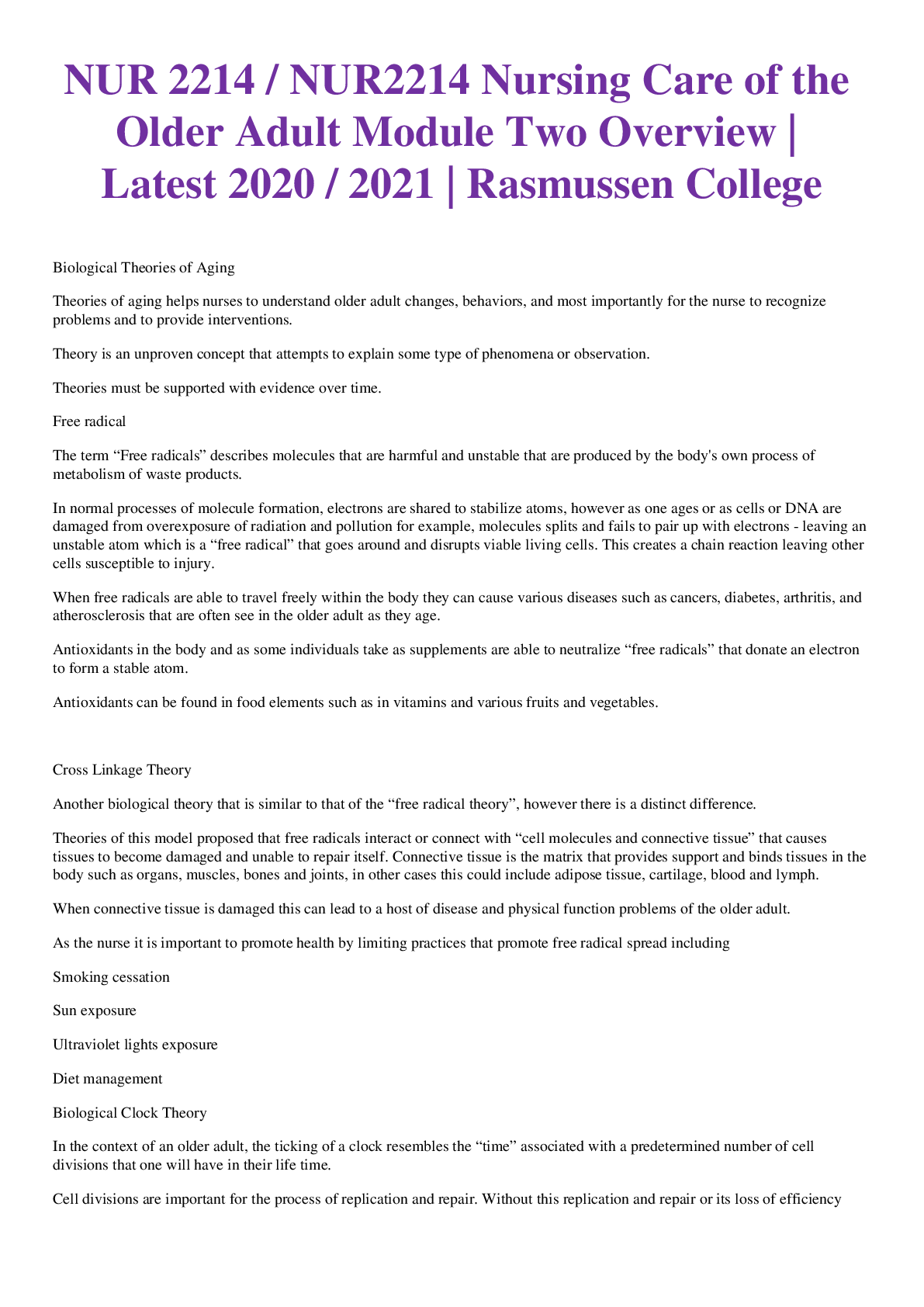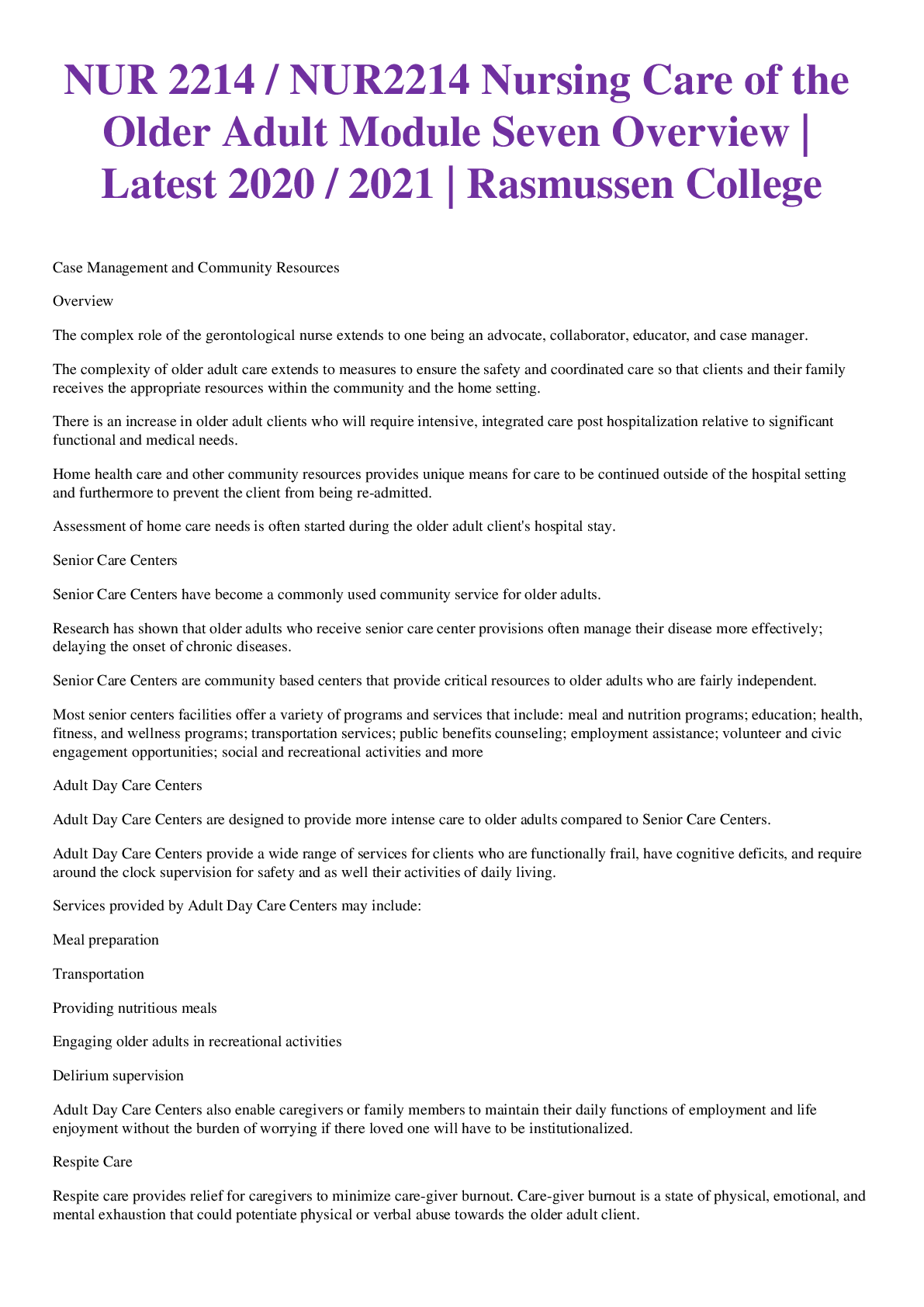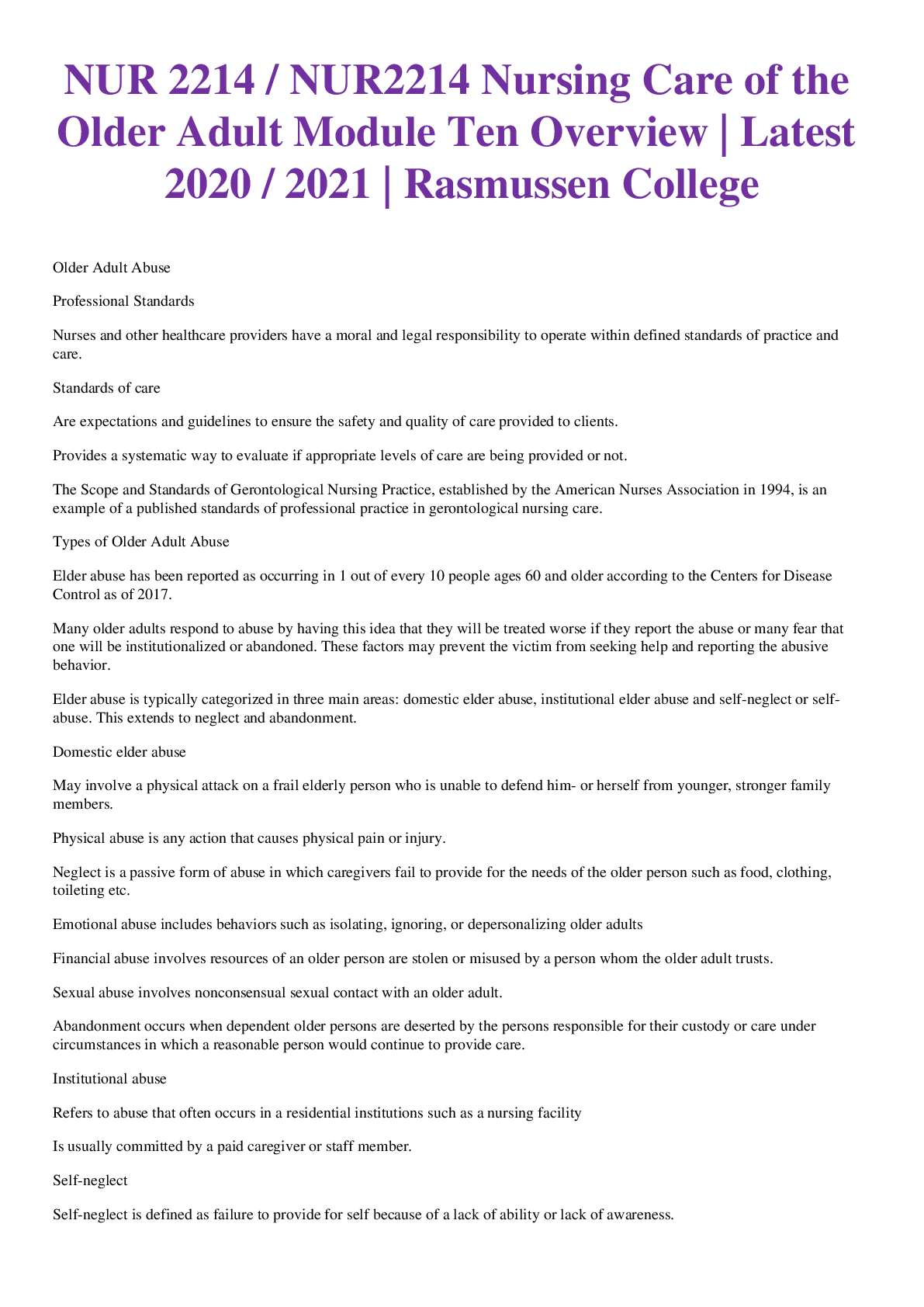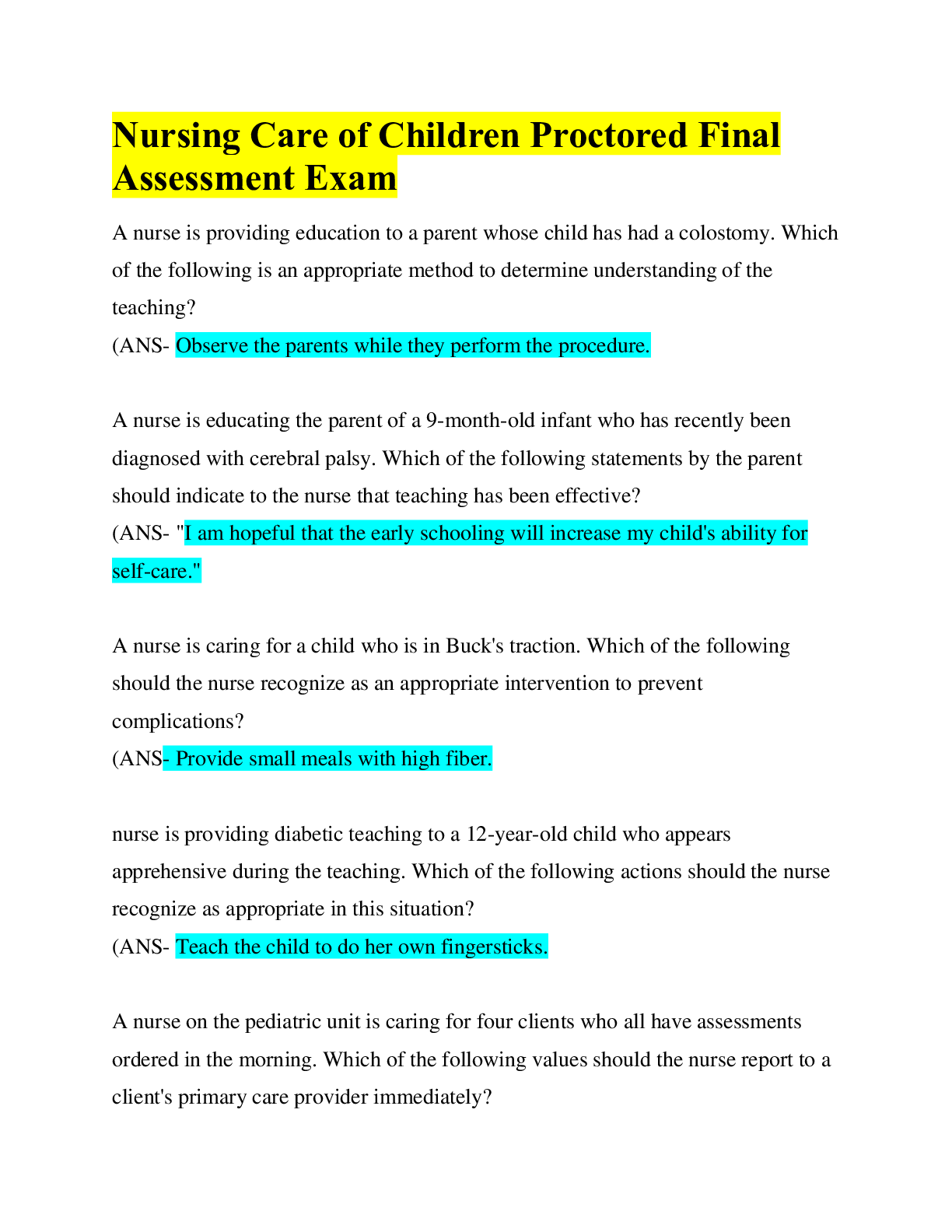*NURSING > EXAM > NSG 300 Nursing care of Children 2 ATI – Our lady of Holy Cross College / NSG 300 Nursing care of (All)
NSG 300 Nursing care of Children 2 ATI – Our lady of Holy Cross College / NSG 300 Nursing care of Children 2 ATI
Document Content and Description Below
NSG 300 Nursing care of Children 2 ATI – Our lady of Holy Cross College. Nursing Care of Children 2 1. A nurse is caring for a 3-year-old child who is in need of a hypospadias repair. Which of... the following should the nurse recognize as a concern to this age group? a. Interruption in toilet training b. Separation from friends at preschool c. Pain from the surgical procedure d. Damage to body integrity 2. A nurse is caring for a 6 week old infant who is admitted to the pediatric acute care unit following pyloromyotomy. The nurse should anticipate the feeding schedule 8 hr postoperative will be which of the following? a. Continuous drip via a nasogastric tube b. Small, frequent bottle feedings c. NPO with intravenous fluids only d. Bolus feedings via a gastrostomy tube 3. A nurse is caring for a child with cystic fibrosis. In planning nutritional care for this child, the nurse should include which of the following actions? a. Increase protein intake. b. Decrease fat intake. c. Increase fiber intake. d. Decrease salt intake. 4. A nurse is caring for a child receiving chemotherapy. The white blood cell count is 1,200/mm3. In planning the child's care, the nurse should prepare to do which of the following? a. Encourage quiet play and maintain bed rest. b. Maintain protective isolation and monitor for fever. c. Monitor oximetry and administer oxygen for dyspnea. d. Protect from injury and monitor for bleeding. 5. A nurse is caring for a child with dehydration. Which of the following should the nurse recognize as an appropriate assessment to determine the child's response to parenteral fluids? a. Weighing the child at the same time every day b. Taking the child’s vital signs every 2 hr c. Measuring the head circumference twice a day d. Counting the number of wet diapers every shift 6. A nurse is caring for a 2-year-old child who has not received any immunizations. During assessment, the child is noted to have a maculopapular rash and fever. The child's parent tells the nurse that the child has been exposed to rubeola. Which of the following assessment findings should the nurse expect? a. Koplik spot b. Vesicles and crusts c. Strawberry tongue d. Paroxysmal cough 7. A nurse is caring for an adolescent with diabetes mellitus who has been admitted twice this year to the hospital with diabetic ketoacidosis. Which of the following tests should the nurse recognize as the best information to evaluate the client’s compliance? a. Hemoglobin A1C b. Fasting blood sugar c. Urinary ketones d. Urine glucose 8. A nurse is caring for a child in skeletal traction. At the change of shift, the nurse finds the client crying in pain, and the right foot is pale and pulseless. Which of the following should the nurse recognize as the appropriate explanation of this finding? a. Severe pain is to be expected; pain medication should be given. b. This child has a low pain tolerance and needs appropriate distraction. c. The traction may be pulling too hard and should be released. d. This is a critically abnormal finding, and the primary care provider must be notified immediately. 9. A nurse is caring for a child with a ventricular septal defect. Which of the following should the nurse expect to assess in the child? a. Acrocyanosis b. Murmur best heard at the lower left sternal border c. Polycythemia d. Clubbing of the nail beds 10. A nurse is caring for a child with acute glomerulonephritis, and an ASO titer is ordered. The child's parent asks the nurse, "Why does the child need this titer?" Which of the following would be an appropriate response by the nurse? a. "It is done to determine the level of antibiotic is the child’s blood." b. "It will tell us if the child ever had the measles." c. "It is done routinely on all clients." d. "It will tell us if the child had a recent strep infection." 11. A nurse is caring for an 8-year-old child who has acute glomerulonephritis. Which of the following should the nurse expect to find with this client? a. Ketones b. Decreased specific gravity c. Streptococcal bacteria d. Elevated red blood cells 12. A nurse is caring for a 4 year old child who has a malfunctioning ventriculo peritoneal shunt. Following new shunt placement, the nurse conducts a postoperative check. Which of the following assessments should the nurse immediately respond to? a. Urinary output 30 mL/2 hr b. Pupils equal and reactive to light c. Blood pressure of 100/60 mm Hg, apical pulse of 90 d. Sleepy, very difficult to arouse 13. A nurse is caring for a preschooler diagnosed with human immunodeficiency virus who is at the clinic to receive immunizations. Which of the following statements about HIV immunizations for this child is the most appropriate? a. All immunizations are to be given, just in smaller dosages. b. The only immunization contraindicated for this client is the oral polio. c. Immunizations will be delayed until the infant tests HIV negative. d. No immunizations should be given at this time. 14. A nurse is caring for a 6 year old child who is newly diagnosed with diabetes mellitus. The nurse is educating the child on how to do finger sticks for blood glucose checks. The nurse knows the most effective method to teach this skill will be to do which of the following? a. Provide constructive criticism if not done properly. b. Demonstrate the skill several times. c. Show the child a video of another child doing it. d. Allow the child to practice the skill on themselves or others. 15. A nurse is caring for a newborn with a myelomeningocele. In planning care for the newborn, the nurse should be aware that postoperatively, the child is most prone to developing which of the following? a. Hydrocephalus b. Decubitus c. Otitis media d. Osteomyelitis 16. A nurse is caring for a 4-year-old child who is brought into the emergency room with burns to the neck and face following a house fire. Which of the following assessments should the nurse prioritize for this child at this time? a. Fluid volume insufficiency b. Scar formation c. Breathing pattern d. Presence of infection 17. A nurse is caring for a 6-month-old infant who has been diagnosed with thalassemia major. After providing a teaching plan, the nurse should recognize that the parent understands the disease process when the parent states which of the following? a. "No treatment is necessary for my infant." b. "My infant will require frequent transfusions." c. "I will keep the weekly vitamin B12 injection appointments." d. "My infant will improve with a diet that is high in iron." 18. A nurse is assessing a 4-year-old child at a well-child appointment. The parent expresses concern over the child's stuttering. The nurse provides teaching to the parent. Which of the following statements by the parent indicates a need for further teaching? a. "It may help if you encourage your child to stop and begin the word over." b. "Vocal hesitancy is common in children younger than age 7." c. "Singing songs or nursery rhymes may ease stuttering." d. "Look directly at your child while the child is speaking." 19. A nurse is caring for a toddler who is exhibiting acute respiratory distress. Which of the following findings should alert the nurse to the possible diagnosis of epiglottitis? a. Lethargy b. Spontaneous coughing c. Drooling d. Hoarseness 20. The nurse is caring for a child with bronchiolitis. Assessment findings indicate wheezing, oxygen saturation of 100%, respiratory rate of 40/min, and a heart rate of 92/min. The child is receiving oxygen at 2 LPM. An order is written to wean oxygen maintaining oxygen saturation 95% or greater. Which of the following actions is most appropriate for the nurse to take? a. Make no changes at this time, and reassess the child in another hr. b. Call the doctor with the assessment findings, and ask if the oxygen can be lowered. c. Ask the nursing assistant to remove the nasal cannula when serving the child breakfast. d. Lower the oxygen to 1 L/min, check the oxygen saturation, and reassess the child. 21. A nurse is caring for a 4 month old infant who is admitted with a ventricular septal defect (VSD) and undergoing a cardiac catheterization. Post catheterization, which of the following manifestations should alert the nurse to a potential complication? a. Blood pressure of 96/40 mm Hg b. Apical pulse 140/min c. Groin dressing with small amount of blood noted d. Pedal pulses palpable bilaterally 22. A nurse is caring for an 18-month-old toddler who has been admitted following surgical repair of a cleft palate. Postoperatively, the child complains of thirst. The nurse should provide fluids using which of the following? a. Nasogastric tube b. Straw c. Soft nipple d. Cup 23. A nurse is caring for a 2 month old infant with a ventricular septal defect. Which of the following observations should indicate to the nurse that the child's condition is worsening? a. Weight gain of 275 g b. Heart rate of 120/min c. Soft, flat fontanel d. Audible murmur 24. A nurse observes an adolescent with celiac disease ordering a gluten free breakfast tray. The nurse should know that the client understands the diet when the client orders which of the following items? a. Oatmeal with artificial sweetener b. Cereal with skim milk c. Eggs and orange juice d. Peanut butter and jelly on rye toast 25. A nurse is caring for a 4-year-old child with leukemia. The child has undergone chemotherapy and now has a fever, pallor, fatigue, and petechiae. Based on this information, which of the following should the nurse expect to find? a. Platelet count 50,000/mm3 b. Hemoglobin 6 g/dL c. White blood cells 1,000/mm3 d. Potassium 4.5 mEq/L 26. In planning care for a child with severe reactive airway disease, the nurse knows that when chronic steroid use is indicated, inhaled steroids are preferred over oral steroids for which of the following reasons? a. Inhaled steroids are less likely to cause thrush. b. Oral steroids in liquid preparations taste bad. c. Oral steroids can slow linear growth in children. d. Inhaled steroids are more effective for acute bronchospasm. 27. A nurse is caring for an adolescent with a fiberglass cast. When providing education for the adolescent, which of the following should the nurse explain? a. Place plastic over the cast while bathing b. Discontinue all sports activities c. Take tub baths only d. Prevent writing on the cast 28. A nurse is caring for a child who is diagnosed with Wilms' tumor. Which of the following interventions should the nurse do first? a. Raise the head of the bed for comfort. b. Check vital signs every 8 hr for incidence of hypertension. c. Place a sign over the bed that says "Do Not Palpate the Abdomen". d. Monitor the urinary output every 2 hr. 29. A nurse is providing care to a child with a possible intussusception. The parents of the child ask the nurse how the diagnosis is made. Based on an understanding of the diagnostic evaluation for intussusception, which of the following statements should the nurse use? a. "A barium enema will be given to visualize the obstruction." b. "Genotyping can identify this condition." c. "A biopsy will be done on a small amount of tissue from the colon." d. "An upper GI series should identify the area involved." 30. A nurse is caring for a newborn infant who is suspected of having a tracheo esophageal fistula (TEF). Which of the following nursing assessments would be consistent with this diagnosis? a. Absence of bowel sounds b. Cardiac murmur c. Copious oral secretions d. Acrocyanosis 31. A nurse is caring for a child with a history of diarrhea for 24 hr. The primary care provider orders a urine specific gravity. Which of the following values should the nurse expect to see? a. 1.010 b. 1.030 c. 1.020 d. 1.000 32. A nurse is caring for a child diagnosed with nephrotic syndrome who is receiving Prednisone (Deltasone). Which of the following should the nurse recognize as a therapeutic response of the medication? a. Rectal temperature returns to 37° C (98.6° F) b. Food intake increases c. Respiratory rate decreases from 25 to 16/min d. Weight drops 500 g 33. A nurse is caring for a child who has had a spinal fusion. Which of the following statements by the nurse indicates an understanding of the care of this client? a. "I'll make sure the client ambulates at least twice today." b. "The client must remain absolutely flat in bed at all times." c. "The client can get out of bed only to use the commode." d. "I’ll log roll the client every 2 hr." 34. A nurse is caring for a child with a Milwaukee brace for scoliosis. After educating the adolescent, the nurse evaluates the client understands the proper application and use of the brace. Which of the following statements should indicate to the nurse that the adolescent understands the use of the brace? a. "I can take my brace off to sleep every night at bedtime." b. "I can take my brace off for about an hour to shower daily." c. "I can take my brace off on special occasions only, like dances." d. "I can take my brace off only when I come in for adjustments." 35. A nurse is caring for a child diagnosed with sickle cell anemia. The nurse should make which of the following recommendations to the client regarding sickle cell anemia? a. Closely monitor bowel movements. b. Increase fat intake. c. Increase fluid intake. d. Eat leafy green vegetables daily. 36. A nurse is teaching a 12-year-old child how to use an steroid inhaler. The nurse should recognize that the teaching has been effective when the child makes which of the following statements? a. "I should use this medication as soon as I start to wheeze." b. "I will take this medication immediately before playing any sports." c. "I must use this medication every day even if I don’t have any manifestations." d. "As soon as I stop wheezing, I can stop using this medication." 37. A nurse is caring for a 4 month old infant with otitis media. The nurse is educating the child's parent on how to prevent reoccurrences. Which of the following statements by the parent should the nurse recognize as an understanding of the teaching? a. "I will use ear plugs to keep my baby’s ears from getting wet in the bath tub." b. "I will make sure my baby is sitting upright when drinking a bottle." c. "I will call the clinic promptly if my baby starts pulling at the ears again." d. "I will save any leftover antibiotics in case my baby starts showing manifestations again." 38. A nurse is educating a parent on the treatment for pinworms. Which of the following statements by the parent indicates that teaching has been effective? a. "I will give my child the mebendazole (Vermox) today and in two weeks." b. "I will change my child’s underwear twice a day." c. "I will keep my child out of school until I don’t see the pinworms any more." d. "I will discard the sheets on my child’s bed." 39. A nurse is caring for a child who has had a tonsillectomy. Which of the following findings should the nurse give the most attention to 8 hr after surgery? a. Extreme thirst b. Hoarse voice c. Frequent swallowing d. Sore throat 40. A nurse is caring for a 2 year old child with vomiting and dehydration. Which of the following assessments should prompt the nurse to contact the primary care provider? a. Blood glucose 150 mg/dL b. Potassium 2.5 mEq/L c. Weight loss of 10 g d. Urine specific gravity 1.020 [Show More]
Last updated: 1 year ago
Preview 1 out of 10 pages

Reviews( 0 )
Document information
Connected school, study & course
About the document
Uploaded On
May 26, 2020
Number of pages
10
Written in
Additional information
This document has been written for:
Uploaded
May 26, 2020
Downloads
0
Views
71














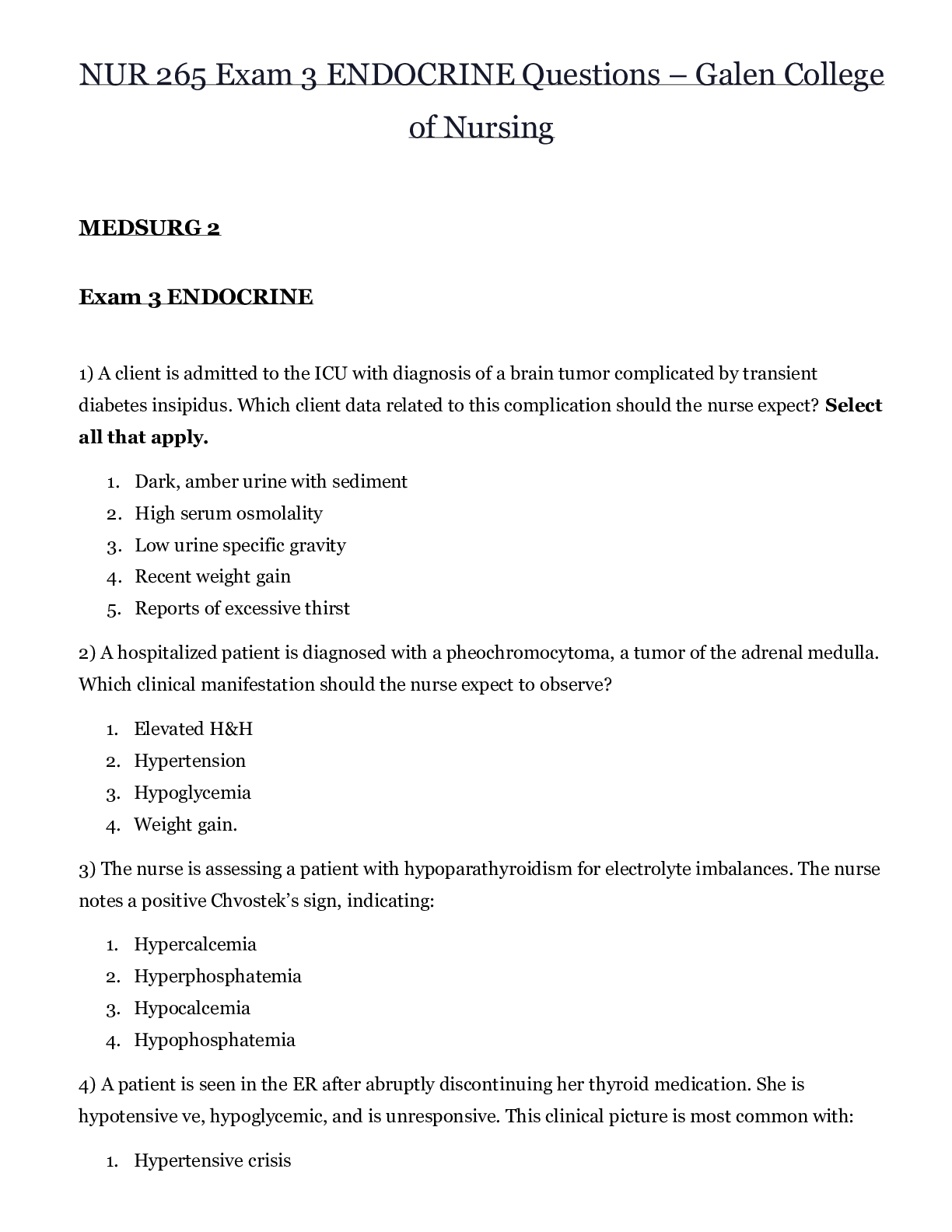
 – CHAMBERLAIN COLLEGE OF NURSING.png)
